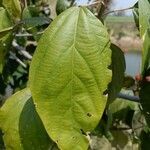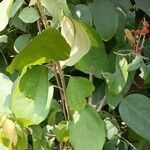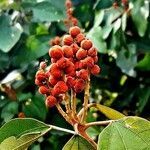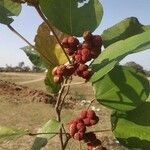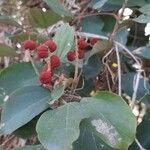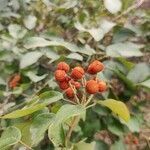| Therapeutic use
|
Analgesics (bark), Anorexia (bark), Anthelmintics (bark), Anti-infective agents, local (bark), Antioxidants (bark), Cathartics (bark), Dermatitis (bark), Diarrhea (bark), Digestive system diseases (bark), Dysmenorrhea (bark), Disorder of ejaculation (bark), Erectile dysfunction (bark), Fractures, bone (bark), Furunculosis (bark), Hemostasis (bark), Jaundice (bark), Muscle cramp (bark), Neoplasms (bark), Parasympatholytics (bark), Pregnancy complications (bark), Pruritus (bark), Puerperal disorders (bark), General tonic for rejuvenation (bark), Simplexvirus (bark), Skin diseases (bark), Hydrocele (bark), Wound healing (bark), Wounds and injuries (bark), Disorder of bone (bark), Anthelmintics (flower), Antirheumatic agents (flower), Abdominal pain (fruit), Abortifacient agents (fruit), Anemia (fruit), Anthelmintics (fruit), Anti-bacterial agents (fruit), Antifungal agents (fruit), Anti-infective agents, local (fruit), Antineoplastic agents (fruit), Antiparasitic agents (fruit), Antipruritics (fruit), Antipyretics (fruit), Antirheumatic agents (fruit), Antitubercular agents (fruit), Antitussive agents (fruit), Aphrodisiacs (fruit), Blister (fruit), Burns (fruit), Cardiotonic agents (fruit), Cathartics (fruit), Constipation (fruit), Contraceptive agents (fruit), Contraceptives, oral (fruit), Cough (fruit), Diabetes mellitus (fruit), Diarrhea (fruit), Digestive system diseases (fruit), Dyspnea (fruit), Disorder of ejaculation (fruit), Erectile dysfunction (fruit), Exanthema (fruit), Furunculosis (fruit), Galactogogues (fruit), Hemorrhage (fruit), Hemorrhoids (fruit), Hemostasis (fruit), Hemostatics (fruit), Herpes simplex (fruit), Hypersensitivity (fruit), Hypoglycemic agents (fruit), Insect repellents (fruit), Intestinal diseases (fruit), Jaundice (fruit), Laxatives (fruit), Leprosy (fruit), Lithiasis (fruit), Menorrhagia (fruit), Menstruation disturbances (fruit), Neck pain (fruit), Otitis media (fruit), Parasympatholytics (fruit), General tonic for rejuvenation (fruit), Scabies (fruit), Skin diseases (fruit), Snake bites (fruit), Splenic diseases (fruit), Splenomegaly (fruit), Stomach diseases (fruit), Urinary bladder calculi (fruit), Urinary calculi (fruit), Urination disorders (fruit), Wound healing (fruit), Wounds and injuries (fruit), Anorexia (leaf), Anthelmintics (leaf), Antirheumatic agents (leaf), Antitubercular agents (leaf), Antitussive agents (leaf), Appetite stimulants (leaf), Asthma (leaf), Bronchitis (leaf), Burns (leaf), Cathartics (leaf), Contusions (leaf), Dermatitis (leaf), Dysmenorrhea (leaf), Eye diseases (leaf), Filariasis (leaf), Flatulence (leaf), Furunculosis (leaf), Infection (leaf), Liver diseases (leaf), Menstruation disturbances (leaf), Muscle cramp (leaf), Neoplasms (leaf), Parasympatholytics (leaf), Pruritus (leaf), Simplexvirus (leaf), Skin diseases (leaf), Hydrocele (leaf), Urinary calculi (leaf), Wound healing (leaf), Wounds and injuries (leaf), Antipyretics (root), Cathartics (root), Disorder of ejaculation (root), Erectile dysfunction (root), Hemostasis (root), Joint diseases (root), Pregnancy (root), General tonic for rejuvenation (root), Skin diseases (root), Anorexia (seed), Anthelmintics (seed), Anti-bacterial agents (seed), Antifungal agents (seed), Anti-inflammatory agents (seed), Antineoplastic agents (seed), Antirheumatic agents (seed), Blister (seed), Burns (seed), Cathartics (seed), Dermatitis (seed), Diabetes mellitus (seed), Dysmenorrhea (seed), Furunculosis (seed), Jaundice (seed), Joint diseases (seed), Menstruation disturbances (seed), Muscle cramp (seed), Neoplasms (seed), Night blindness (seed), Parasympatholytics (seed), General tonic for rejuvenation (seed), Simplexvirus (seed), Skin diseases (seed), Snake bites (seed), Urination disorders (seed), Vitiligo (seed), Wound healing (seed), Wounds and injuries (seed), Dental caries (stem), Antifungal agents (trichome), Constipation (trichome), Hemorrhage (trichome), Herpes simplex (trichome), Intestinal diseases, parasitic (trichome), Jaundice (trichome), Kidney calculi (trichome), Anti-poisoning (trichome), Scabies (trichome), Ulcer (trichome), Urinary bladder calculi (trichome), Antifertility (unspecified), Antioxidant (unspecified), Hair-Oil (unspecified), Herpes (unspecified), Lithontriptic (unspecified), Poison (unspecified), Scabies (unspecified), Styptic (unspecified), Taenifuge (unspecified), Tumor(Abdomen) (unspecified), Sore (unspecified), Vermifuge (unspecified), Bactericide (unspecified), Cyanogenetic (unspecified), Parasiticide (unspecified), Piscicide (unspecified), Ringworm (unspecified), Skin (unspecified), Abortifacient agents (unspecified), Acne vulgaris (unspecified), Anthelmintics (unspecified), Antidotes (unspecified), Antifungal agents (unspecified), Antineoplastic agents (unspecified), Antiparasitic agents (unspecified), Aphrodisiacs (unspecified), Ascites (unspecified), Cathartics (unspecified), Cough (unspecified), Diarrhea (unspecified), Eczema (unspecified), Exanthema (unspecified), Flatulence (unspecified), Furunculosis (unspecified), Hemorrhage (unspecified), Hemostasis (unspecified), Hemostatics (unspecified), Herpes simplex (unspecified), Laxatives (unspecified), Freckles (unspecified), Anti-poisoning (unspecified), Puerperal disorders (unspecified), Skin diseases (unspecified), Ulcer (unspecified), Urinary bladder calculi (unspecified), Wounds and injuries (unspecified), Endocrine system diseases (unspecified), Anti-infective agents (whole plant), Central nervous system diseases (whole plant excluding root)
|
